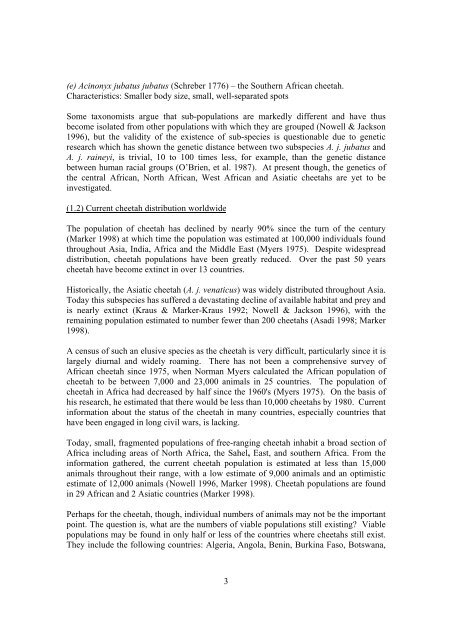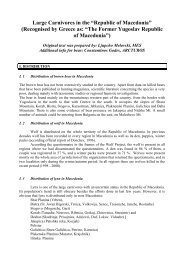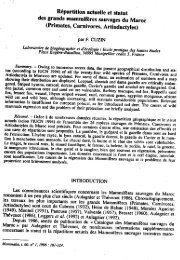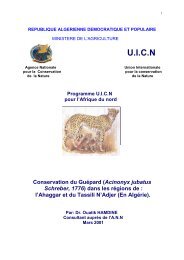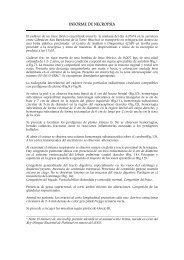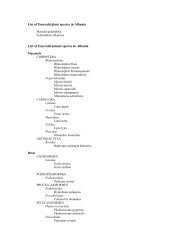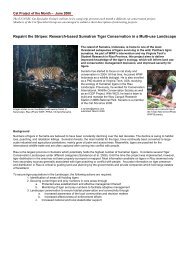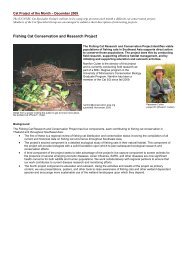cheetah capture and immobilisation handbook - Cat Specialist Group
cheetah capture and immobilisation handbook - Cat Specialist Group
cheetah capture and immobilisation handbook - Cat Specialist Group
You also want an ePaper? Increase the reach of your titles
YUMPU automatically turns print PDFs into web optimized ePapers that Google loves.
(e) Acinonyx jubatus jubatus (Schreber 1776) – the Southern African <strong>cheetah</strong>.<br />
Characteristics: Smaller body size, small, well-separated spots<br />
Some taxonomists argue that sub-populations are markedly different <strong>and</strong> have thus<br />
become isolated from other populations with which they are grouped (Nowell & Jackson<br />
1996), but the validity of the existence of sub-species is questionable due to genetic<br />
research which has shown the genetic distance between two subspecies A. j. jubatus <strong>and</strong><br />
A. j. raineyi, is trivial, 10 to 100 times less, for example, than the genetic distance<br />
between human racial groups (O’Brien, et al. 1987). At present though, the genetics of<br />
the central African, North African, West African <strong>and</strong> Asiatic <strong>cheetah</strong>s are yet to be<br />
investigated.<br />
(1.2) Current <strong>cheetah</strong> distribution worldwide<br />
The population of <strong>cheetah</strong> has declined by nearly 90% since the turn of the century<br />
(Marker 1998) at which time the population was estimated at 100,000 individuals found<br />
throughout Asia, India, Africa <strong>and</strong> the Middle East (Myers 1975). Despite widespread<br />
distribution, <strong>cheetah</strong> populations have been greatly reduced. Over the past 50 years<br />
<strong>cheetah</strong> have become extinct in over 13 countries.<br />
Historically, the Asiatic <strong>cheetah</strong> (A. j. venaticus) was widely distributed throughout Asia.<br />
Today this subspecies has suffered a devastating decline of available habitat <strong>and</strong> prey <strong>and</strong><br />
is nearly extinct (Kraus & Marker-Kraus 1992; Nowell & Jackson 1996), with the<br />
remaining population estimated to number fewer than 200 <strong>cheetah</strong>s (Asadi 1998; Marker<br />
1998).<br />
A census of such an elusive species as the <strong>cheetah</strong> is very difficult, particularly since it is<br />
largely diurnal <strong>and</strong> widely roaming. There has not been a comprehensive survey of<br />
African <strong>cheetah</strong> since 1975, when Norman Myers calculated the African population of<br />
<strong>cheetah</strong> to be between 7,000 <strong>and</strong> 23,000 animals in 25 countries. The population of<br />
<strong>cheetah</strong> in Africa had decreased by half since the 1960's (Myers 1975). On the basis of<br />
his research, he estimated that there would be less than 10,000 <strong>cheetah</strong>s by 1980. Current<br />
information about the status of the <strong>cheetah</strong> in many countries, especially countries that<br />
have been engaged in long civil wars, is lacking.<br />
Today, small, fragmented populations of free-ranging <strong>cheetah</strong> inhabit a broad section of<br />
Africa including areas of North Africa, the Sahel, East, <strong>and</strong> southern Africa. From the<br />
information gathered, the current <strong>cheetah</strong> population is estimated at less than 15,000<br />
animals throughout their range, with a low estimate of 9,000 animals <strong>and</strong> an optimistic<br />
estimate of 12,000 animals (Nowell 1996, Marker 1998). Cheetah populations are found<br />
in 29 African <strong>and</strong> 2 Asiatic countries (Marker 1998).<br />
Perhaps for the <strong>cheetah</strong>, though, individual numbers of animals may not be the important<br />
point. The question is, what are the numbers of viable populations still existing? Viable<br />
populations may be found in only half or less of the countries where <strong>cheetah</strong>s still exist.<br />
They include the following countries: Algeria, Angola, Benin, Burkina Faso, Botswana,<br />
3


